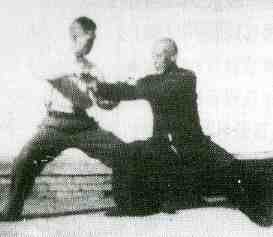
It can be, and most certainly is a martial practice. However, that has to be understood in a certain light. As a martial practice, push hands is Gongfu. It is a training method for developing Gong. It is not combat application training in and of itself, but rather a methodology of training the mind and body to act and react under certain conditions. One can use push hands to learn how to transition into Chin Na or Dim Mak, and, as is quite the rage in some circles, grappling. It is a practice for learning to listen and pay attention to a partner/opponent, and serves to teach the subconscious mind how to respond reactively in a tense situation that doesn't lend itself to thinking or pre-planning. Combat push hands, and the sticky hands/spinning hands of some arts such as Yiquan and I Liq Chuan are very solid training tools for self defense skills. Given all that, Gongfu is not always combat-oriented. Gongfu means developing skill or the building of essential foundation. According to my teacher, Dr. Yang, “The accumulation of gong refers to constant improvements in balance, coordination, agility, and power through the accretion and replenishment of Qi (Yang, pp15)". So we can see this applies to surfing, singing, and walking down the street as much as it applies to self defense. To that end, the same training we use to develop martial skills also serves to develop basic health and physical durability skills.
Push hands is also an excellent practice for developing stress management skills. Consider the perspective that if we can learn to deal with a person, with whom we are not intimate, intruding in on our personal space and, even gently, trying to disrupt our balance, that we we are developing the necessary skills to deal with an aggressive driver in rush hour traffic, or a disrespectful teenager in our living room. Push hands practice can be seen as a laboratory for inducing minor stress in a controlled environment so that we can learn the best, and for that matter, worst ways to act and react within that situation. Push hands practice is an embodied and applied application of Taiji and meditation training. It is beneficial to be calm, collected, and at peace practicing your form or sitting on a cushion, but can you take that same calm and apply it under duress? While the odds of getting mugged are actually quite low for most of us, the odds of experiencing environmentally-induced stress are quite high. You can not always control the stressor, but you can control your reactions.
Another quite valid and useful construct for push hands practice is as a tool for mindfulness. In a basic playful format where each player is intent on disrupting the other's balance, being mindfully present in each moment is crucial. An obvious challenge for anyone who attempts meditation is dealing with the tendency of the mind to wander and get lost in thought. First of all, that is not necessarily as bad as it is always presented or as it feels, but that is a discussion for another time. The point is there are benefits in calming monkey mind. Sitting meditation is the most common practice for this. And many teachers, myself included, advise folks to learn to be mindful in all waking moments; to be present to life as it happens, to change with the change and go with the flow. Gentle, cooperative push hands is a wonderful tool for further developing this skill. From this perspective the competitive tendency is diminished and it becomes a completely different practice.
Of course this is nowhere near a comprehensive survey of push hands practice, but a couple of considerations I find useful to consider when practicing or teaching. Like all things Neija, the possibilities and potentials are endless. That's what makes it so great.
Reference:
Taijiquan: The Art of Nurturing, The Science of Power. Yang, 2008. Zhenwu Publications
 RSS Feed
RSS Feed
